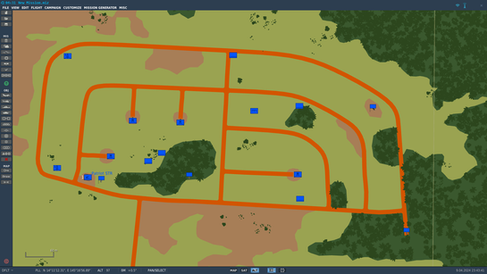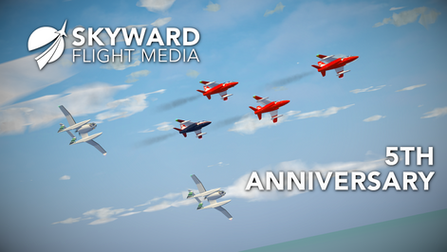Increasing Mission Complexity By Using Realistic Dispersal Tactics

I subscribe to the belief that Digital Combat Simulator can be a "jump scare simulator". Unexpected encounters I had with surface-to-air missiles (SAM) slamming me in the face or flying in formation with telephone pole sized missiles are flooding my mind.
After months of research and testing related to these complex missile systems, I began to notice a trend with the way SAM sites appear in various multiplayer servers. Even the most popular downloadable multiplayer focused missions follow this trend. The dispersal of medium and long-range SAM sites essentially use the "out of the box" template provided in the mission editor.
In this entry of our DCS Mission Editor series, I want to provide alternatives to the seemingly standard practice of deploying SAM sites in their default templates. In part one, we focus on basic applications that do no require Trigger Zones, Switched Conditions, managing Alert Levels or any moderately difficult additions.
DCS Default Template
When I say "default template" I mean the actual drag and drop template from the built in mission editor. Normally, multi-unit surface-to-air missile sites like the HAWK, NASAMS, Patriot, SA-2 and SA-3 come in a single group. It makes it easy to select the lead unit and drag the entire group to the desired location. That is helpful for mission building, but too often are these high value targets just left in these clusters. These groups are usually roughly 400 meters by 400 meters. Perfect for a cluster munition or a few GPS-guided weapons to disable it in a single pass. Easy to spot and counterattack.

Mission editors that prefer to focus on realistic deployment of SAM batteries would argue that these sites need to operate in a small area because they require support facilities and support vehicles. While true, this is mainly a requirement for more static SAM complexes like the SA-2 Guideline or SA-3 Goa. They are, by design, not highly mobile systems and operate best as permanent fixtures in purpose built locations.

Inspiration From Reality
Using the same application of realism, there are plenty of documented historical cases of more mobile SAM sites in past conflicts utilizing many types of unconventional dispersal methods. During Operation Allied Force (1999), NATO air forces found the Serbian deployed SA-6 Gainful to be surprisingly resilient because of its use of "shoot and scoot" tactics. After launching their missiles at NATO combat aircraft, the SA-6 units would disperse to other pre-prepared locations, where more ammunition and support infrastructure was on standby for their arrival. The SA-6 continued to be an ongoing threat throughout the campaign, despite the launch of 743 AGM-88 High-speed Anti-Radiation Missiles.
More recently, the ongoing Russo-Ukrainian War (2022) has made the dispersion of SAM sites a requirement along its vast frontline. The Patriot PAC-2 under Ukrainian control has gained notoriety for destroying multiple aircraft within minutes and intercepting hypersonic missiles. Part of its success may be hinted at in a video from a Russian reconnaissance drone assisting in the destruction of two truck mounted Patriot missile launchers near the frontline. These launchers being detached far from their radar emitters, where they are least expected, seem to imply just how the Patriot is being so effective.
Basic SAM Dispersal Suggestions
In Digital Combat Simulator, multi-unit surface-to-air missile sites can be spread out as far as 25 nautical miles. SAM sites like the NASAMS, Patriot, SA-6, SA-10 and SA-11 are designed for use in combat while being dispersed from traditional support facilities. Let's take a look at some examples that can be used in the DCS mission editor.
Example A: Expanded Dispersion
In the Mission Editor, click "Create and Modify Templates". Select the Country and type of pre-made Surface to Air Missile group of units you want. Find a place on the map of choice to click the ground and spawn the template of vehicles. Be sure to deselect "Create and Modify Templates" to avoid accidentally spawning duplicate groups.
While the core of this group can remain relatively close to one another in a configuration similar to the original template, a minimal effort to slightly spread them out according to the terrain would be beneficial.
Select an existing missile launcher unit from the now placed template or create a new one launcher unit. Place that unit far from the core of the SAM group, but still within 25 nautical miles of the necessary search and track radars. It is important that each launcher have a supply vehicle of some type to reload the missile launchers, as they are no longer receiving ammunition from the supply vehicles in the core of the group.
In this example, a quad-mount missile launcher is now detached from the main group of the Patriot battery. As hostile aircraft attempt to attack the search and track radar at the main group, they will find themselves being engaged by this detachment that is 9.30 nautical miles to the south-west. For the attacking aircraft, suddenly having a threat from an unexpected direction and potentially from a shorter distance than expected could be fatal or at least throw off any original attack plan to disable the Patriot site.

Example B: Offensive Offset
If the mission editor knows the likely direction of attack players will be using, a majority of missile launchers can be separated from the search and track radars to more advantageous positions. In Example B, an SA-10 Grumble has deployed its missile launcher up to roughly 13 nautical miles to its south, in the direction of hostile forces.

While looking at this layout in the map overview, the radars do seem to be defenseless. However, the effective range of the SA-10's missile launchers both easily covers the radars and is now pushed out towards the incoming hostile aircraft.
Any aircraft attacking using its radar warning receiver and anti-radar weaponry will now have two options. They will either have to fly deep within the effective range of the SA-10 missile engagement envelope, or they will have to individually find each detachment of launchers and destroy them one by one.

While this example only focuses on the SA-10 battery, these SAM sites are often augmented by short range air defenses like anti-aircraft guns, MANPADS or other SAMs like the HQ-7 Red Banner or SA-8 Gecko. This SA-10 has now become quite difficult to deal with.
Example C: Addition of Point Defense
The default AI behavior of SAMs in DCS keeps their radar emitters on at almost all times. This can make most of these SAMs somewhat easy to disable with a single anti-radiation missile from a safe distance. Without having to get involved with trigger conditions or .lua, the easiest way to make these systems more survivable is to add point defense units to protect them.
In Example C, an airfield is being defended by a small SA-6 Gainful battery with two mobile missile launcher units. The SA-6 was first introduced in 1958 and even with upgrades over the decades it became rather outdated by the 1980s. Assuming there are no weapon restrictions placed on the aircraft attempting to destroy the SA-6, in Digital Combat Simulator, there are various air-to-ground munitions that could destroy this SAM site without it being able to defend itself from incoming attack.
The addition of a single SA-15 Tor point defense unit can greatly extend the SA-6's lifespan. Even if attacking players are using standoff weapons like anti-radiation missiles or glide bombs, the SA-15 can launch its own missiles to intercept them at up to 14.0 nautical miles away. Now, rather than the SA-6 being soft enough to disable with a single anti-radiation missile, a concerted effort to either focus fire on the SA-15 or overwhelm the SA-15's interception abilities with a saturation attack on the SA-6.

I hope this gets mission editors thinking about changing things up for their next mission file. In the next entry of this series related to Surface-to-Air Missile Improvements, we will be getting more technical by adding Trigger Zones, specific conditions and support facilities that can be targeted to degrade SAM performance.
About the Writer

Co-founder of Skyward Flight Media. After founding Electrosphere.info, the first English Ace Combat database, he has been involved in creating flight game-related websites, communities, and events since 2005. He explores past and present flight games and simulators with his extensive collection of game consoles and computers. Read Staff Profile.































.png)